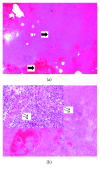Why Asplenic Patients Should Not Take Care of the Neighbour's Dog? A Fatal Course of Capnocytophaga canimorsus Sepsis
- PMID: 30174969
- PMCID: PMC6098898
- DOI: 10.1155/2018/3870640
Why Asplenic Patients Should Not Take Care of the Neighbour's Dog? A Fatal Course of Capnocytophaga canimorsus Sepsis
Abstract
Capnocytophaga canimorsus (CC) belongs to the family Flavobacteriaceae which physiologically occurs in the natural flora of the oral mucosa of dogs and cats. In patients with a compromised immune system, CC can induce a systemic infection with a fulminant course of disease. Infections with CC are rare, and the diagnosis is often complicated and prolonged. We describe a patient with a medical history of prior splenectomy who presented with an acute sepsis and disseminated intravascular coagulation (DIC) and was initially treated on Waterhouse-Friderichsen syndrome (WFS). After the patient had died despite forced treatment in the intermediate care unit, the differential diagnosis of CC was confirmed by culture of blood smears. Later on, a retrospective third-party anamnesis revealed that the patient had contact to his neighbour's dog a few days before disease onset. In conclusion, patients with CC infection can mimic WFS and therefore must be included in the differential diagnosis, especially in patients with a corresponding medical history of dog or cat bites, scratches, licks, or simple exposure.
Figures






References
-
- Brenner D. J., Hollis D. G., Fanning G. R., Weaver R. E. Capnocytophaga canimorsus sp. nov. (formerly CDC group DF-2), a cause of septicemia following dog bite, and C. cynodegmi sp. nov., a cause of localized wound infection following dog bite. Journal of Clinical Microbiology. 1989;27(2):231–235. - PMC - PubMed
Publication types
LinkOut - more resources
Full Text Sources
Other Literature Sources
Miscellaneous

